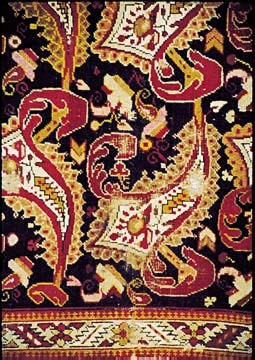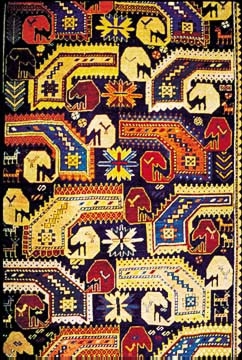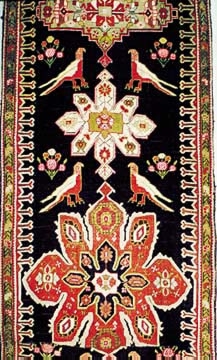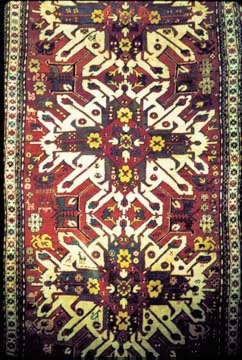|

Summer 2000 (8.2)
Pages
56-59
Carpets Made
to Last
A Walk
Through Baku's National Carpet Museum

Above: The Carpet Museum is
now housed in what used to be the Lenin Museum. Photo: Azerbaijan
National Photo and Cinema Archives
While
touring Baku, you're likely to discover that many of its museums
are found in buildings that were constructed for entirely different
purposes. Take the former Lenin museum, for instance. As with
corresponding Lenin museums in other Soviet republics, Baku's
version once displayed items related to Lenin's life: letters,
speeches, telegrams - even replicas of his clothing.
Lenin, the founder of the Soviet system, believed material wealth
should be shared - not accumulated in the hands of a privileged
few. A generation ago, it would have been inconceivable that
the museum honoring his memory would eventually be transformed
into an Azerbaijani repository of material items representing
wealth. The collection, compiled by the National Carpet Museum,
celebrates the treasures of Azerbaijani craftsmanship. Exhibited
items include primarily carpets, but jewelry and copper vessels
are also on display.

Above: Saddle bags and horse
blankets are also on display at the Carpet Museum. Photo: Blair
_____
The State Museum of Azerbaijani Carpets and Decorative Applied
Arts named after Latif Karimov holds close to 10,000 items, including
a wide range of carpets, traditional clothing, jewelry, shoes
and copper goods like plates, jugs, mugs and samovars.

Above: Floor plan of Art Museum
by Shamil Fatullayev. Formerly Lenin Museum in Baku, Azerbaijan
The museum first opened in 1967 in a former mosque in Ichari
Shahar (Inner City) known as the Friday Mosque. The mosque was
built in the 15th century and renovated in the late 19th century.
During the Soviet period, it was closed but not torn down, unlike
most of the mosques in Baku. In 1992, after Azerbaijan gained
its independence, the Carpet Museum moved to its current location
- the former Lenin Museum. The Friday Mosque has been returned
to its original purpose as a house of worship.
  Karimov's Legacy Karimov's Legacy
Left: Latif Karimov, carpet
weaver who systematized carpet types in Azerbaijan.
The
museum is named after Latif Karimov (1906-1991), who established
the collection in 1967. Karimov was a scholar and carpet-maker
who meticulously researched the history of Azerbaijani carpets
and systematized 144 styles based on geographical regions (cities,
towns, villages).
These are subgrouped under four major regional groups, which
include (1) Guba-Shirvan (which also includes Baku); (2) Ganja-Kazakh;
(3) Karabakh (which also includes Shusha and Jabrayil) and (4)
Tabriz (southern Azerbaijan in Iran which also includes carpet
styles of Ardebil).
Karimov was born in Shusha, which has been occupied by Armenian
military forces since 1992 when all Azerbaijanis were forced
to flee. He then moved with his family to Mashad, Iran in 1912.
During his childhood, he became inspired by the beautiful carpets
that he saw there and often helped his mother weave carpets.
In 1934, he created his masterpiece portrait of Ferdowsi - an
ornamental carpet dedicated to the 1,000th Anniversary of the
poet - which went on display at the International Exhibition
in Paris in 1937.
  Later,
as Director of the Carpet Weaving faculty at Azerbaijan's Academy
of Sciences, Karimov became an expert in the field of carpet
arts and wrote a three-volume series entitled "Azerbaijan
Carpet." Later,
as Director of the Carpet Weaving faculty at Azerbaijan's Academy
of Sciences, Karimov became an expert in the field of carpet
arts and wrote a three-volume series entitled "Azerbaijan
Carpet."
He identified four major types of Azerbaijani carpets based on
geographical origin - namely, the Guba-Shirvan, Ganja-Gazakh,
Garabagh (Karabakh) and Tabriz (Iran) schools. Each school has
its own distinct characteristics and coloring; examples of each
school are on display at the Carpet Museum.
Left: Director of the Carpet
Museum, Roya Taghiyeva.
Though carpets vary according to region, there are some general
characteristics of Azerbaijani carpets characterized by their
symmetry, bold design and juxtaposition of colors. Of course,
there are exceptions to every generality.
Scholars continue Karimov's research at today's Carpet Museum.
Both modern and ancient carpets are collected from private parties,
then sorted according to type. Exhibits are divided between knotted
and flat weave and the region to which the carpets belong. For
instance, the museum has carpets from Southern Azerbaijan (now
part of Iran) as well as from Azerbaijani villages in Armenia
and Georgia. Of the museum's collection of 6,000 carpets, about
1,300 of them are on display at any one time.
The Karabakh Collection
The museum's permanent collection includes a group of carpets
from the former Shusha Carpet Museum. When Shusha - the cultural
center of the Karabakh - came under siege by Armenians in early
1992, there was a real danger that the museum's carpets would
be lost or destroyed in the war. In an effort to preserve these
rare artifacts, the Shusha museum's director, arranged for 600
carpets to be evacuated from the city in army vehicles. Today
the carpets can be found at the Baku museum in an exhibition
titled "Burnt Culture."
 |

|
Above left and
right: Some
samples of carpets which are on display at the Carpet Museum.
Photos: Blair
Must-See Carpets
One of the oldest carpets on display at Baku's Carpet Museum
is a 17th-century fragment from the Tabriz Carpet School. Tabriz,
a city in South Azerbaijan, founded its own carpet school during
the Middle Ages. Tabriz-style carpets tend to depict hunting
scenes, images from Nizami and Omar Khayyam poems as well as
popular legends. Flowers and branches often ornament the elaborate,
colorful displays.
Left: A sample of carpets
which are on display at the Carpet Museum.
Right: Sunburst pattern typical
of some Azerbaijani carpets.
The museum's oldest specimen from the Tabriz School, known as
"Shah Abbas", depicts a hunting scene in bold colors:
dark blue and dark red. Shah Abbas (1587-1629) was an Azerbaijani
and Safavid king who Persianized the country. The carpet's complicated,
delicate design borrows from a style of miniature art that originated
in Tabriz' influential Miniatures School in the 16th century.
As with other carpets from Tabriz, "Shah Abbas" is
made of wool with a thick pile, as opposed to "palaz",
a type of carpet without pile.
Baku also had its own school for carpet-making. "Khila Afshan",
an 18th-century carpet displayed at the museum, was made in Baku's
Khila village (now known as Amirjan). "Afshan" refers
to a specific style that was adapted from the Tabriz school.
Whereas Afshan carpets from Tabriz have soft, subtle colors without
much variation, the Baku version of the Afshan design stands
out in its use of contrasting colors: red, white, and dark blue.
The wool carpet is decorated throughout with flowers; individual
petals frame the edges.
Wedding Gifts
Some of the carpets on display are family heirlooms that were
sold or donated to the museum. For instance, scholars at the
museum suspect that the 1724 "Khurjun" (saddlebag)
on display was given by a bride-to-be to her future husband.
It used to be a tradition for brides to give a saddlebag and
horsecloth to their grooms as a wedding present. The cloth shows
little signs of wear, indicating that it was probably passed
down from generation to generation but never used.
The saddlebag's design is composed of a series of diamonds, a
pattern that was specific to the Gobustan carpets of the Shirvan
school. Vibrant colors like red, green, blue and white dominate
the 118 x 47 cm cloth.
Another probable wedding present is the "Chul" (horsecloth)
made in 1727. This cloth was also made in the Shirvan style,
but is slightly larger and features a different design from the
saddlebag. On it, mythological birds symbolize a wish for happiness.
The coloring is also slightly different, featuring dark red,
light green, yellow and dark blue as dominant colors.
One of the museum's most striking exhibits is a carpet that was
made only a few decades ago. Latif Karimov's "Song of Centuries"
carpet, made in 1980, combines ancient motifs from the various
carpet schools of Azerbaijan. Human beings, mythical birds and
other animals all share the same space in this tribute to the
history of Azerbaijani carpet-making. Dark blue and black are
contrasted with lighter shades such as white and yellow.
Public Outreach
Items from the Carpet Museum often are sent on exhibit to other
countries. For example, in 1998 UNESCO organized an exhibition
in Paris featuring carpets and everyday utensils from the Middle
Ages. The conference was held on the occasion of the poet Fuzuli's
Jubilee. In 1999, carpets traveled from the museum to another
exhibition in Paris that was devoted to Dada Gorgud's 1,300th
Jubilee. An upcoming exhibition in Hanover, Germany will give
the museum a chance to display some of its Azerbaijani folk applied
art items, including copper jugs, mugs, buckets and saddle-bags.
Within the community, the Carpet Museum organizes lectures and
often invites students from local schools to come to the museum
to learn more about the art of carpet-making.
To supplement the museum collection, Director Roya Taghiyeva
has written a book called "Azerbaijan's Carpet" (1999).
The 262-page book features hundreds of color photos depicting
the historical development of Azerbaijan's carpet. It was published
by BP Amoco with support from the UN, UNDP and Baku Art and Culture
Helpers. The volume is available for sale at the Carpet Museum.
National
Carpet Museum
123 Neftchilar Avenue (former Lenin Museum),
Tel: (99-412) 93-05-01, 93-66-85
Hours: Tuesday to Sunday, 9 a.m. to 6 p.m., closed Mondays
Admission: 3,000-12,000 manats
Students: 1,000 manats; extra charge for guide
Roya Taghiyeva, Director of the Museum,
and Khadija Asadova, Scientific Secretary, were both interviewed
by Farida Sadikhova.
From Azerbaijan
International
(8.2) Summer 2000.
© Azerbaijan International 2000. All rights reserved.
Back to Index
AI 8.2 (Summer 2000)
AI Home
| Magazine Choice | Topics
| Store
| Contact
us
|









